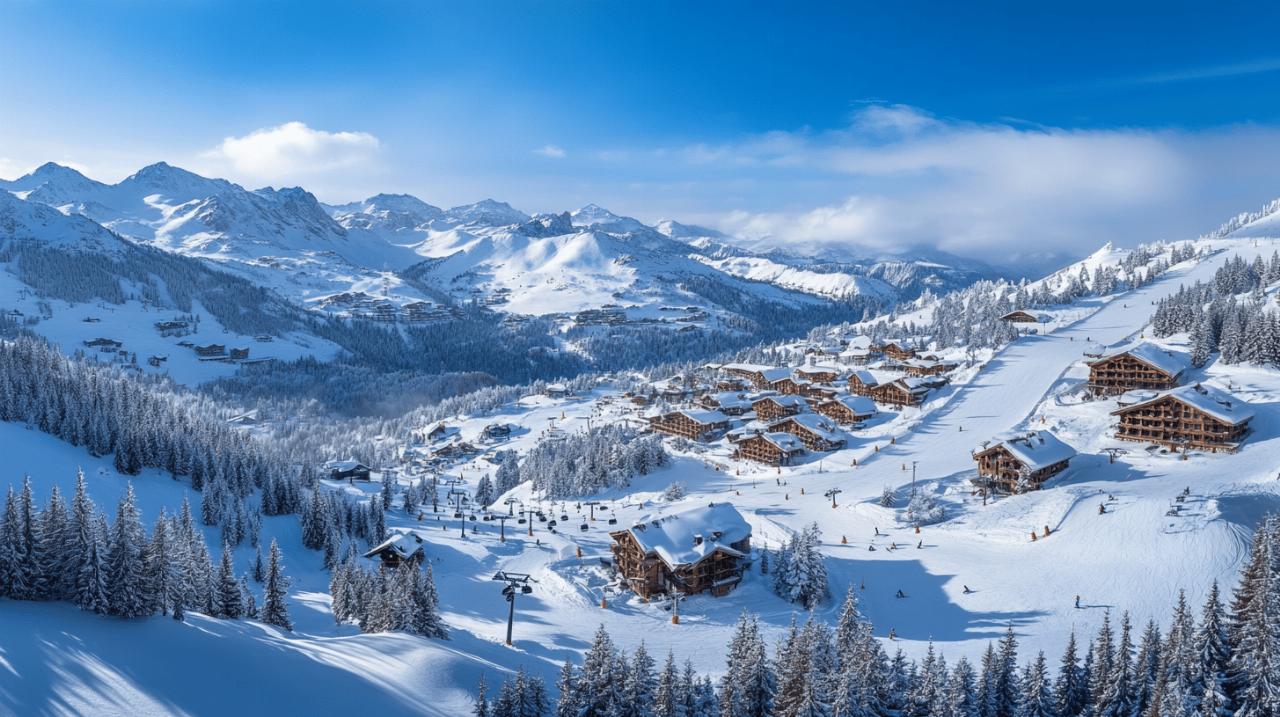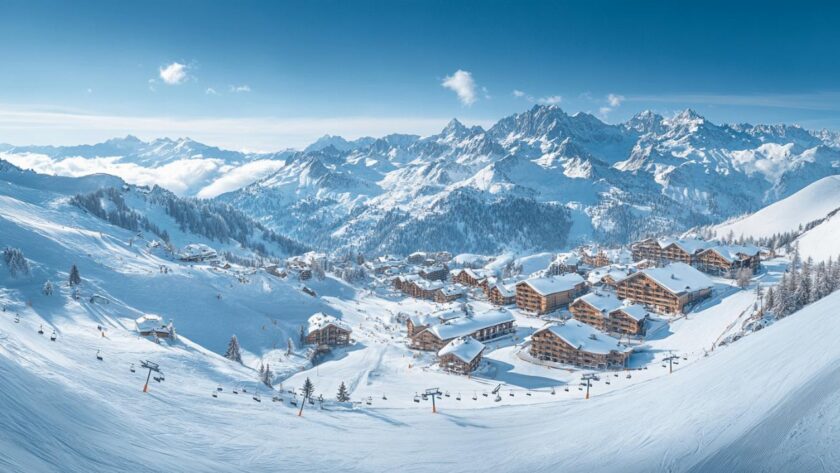The world of skiing offers remarkable paradoxes—some of the largest winter playgrounds on Earth exist in places far removed from everyday life. These hidden giants, massive ski areas that span mountains and valleys, offer extraordinary experiences for those willing to seek them out.
Mapping the Colossal: Understanding What Makes a Ski Resort 'Large'
When we talk about the world's largest ski resorts, we're referring to sprawling winter wonderlands that defy typical boundaries. These are not merely ski hills but interconnected networks of slopes, lifts, and Alpine villages that can take days or even weeks to fully explore.
Measuring greatness: skiable terrain, vertical drop, and lift networks
The metrics of ski resort size vary by region. In North America, resorts like Whistler Blackcomb in British Columbia boast an impressive 8,171 acres of skiable terrain with 37 lifts serving more than 200 runs. Park City in the United States follows closely with over 7,300 acres, 330+ runs, and 40 lifts. European resorts are typically measured by ski run length rather than acreage, with France's Les 3 Vallées reigning supreme at 600 kilometers (372.8 miles) of slopes, served by 166 lifts connecting 328 distinct runs. Italy's Sella Ronda impresses with 500 kilometers of slopes spanning four ski valleys, while Paradiski in France offers 425 kilometers of diverse terrain.
The Balance Between Size and Accessibility in Remote Locations
While these massive ski areas provide unparalleled opportunities for winter sports enthusiasts, their remote locations present both challenges and rewards. Many of the world's largest ski resorts balance accessibility with isolation. Some, like Val d'Isere-Tignes in France, position 60% of their slopes above 7,218 feet, ensuring reliable snow conditions but requiring dedicated travel. Others, such as Saint Martin de Belleville, offer authentic Alpine village experiences with cobbled streets and stone buildings while still providing access to the enormous 3 Vallées ski area. These hidden gems among giants allow visitors to experience massive ski terrain without the crowds that typically accompany world-famous resorts.
European alps: france's dominant ski domains
When discussing the largest ski resorts globally, the European Alps stand as undisputed titans in the skiing world. France particularly dominates the rankings with an impressive collection of interconnected ski domains that offer vast skiable terrain across breathtaking mountain landscapes. These hidden giants provide extraordinary skiing experiences while often nestled in relatively isolated regions, combining immense scale with Alpine authenticity.
The legendary three valleys: courchevel, méribel, and val thorens
Les 3 Vallées claims the crown as the world's largest ski area, boasting an astonishing 600 kilometers (372.8 miles) of marked slopes. This massive network connects the sophisticated resort of Courchevel, the centrally located Méribel, and Val Thorens—Europe's highest ski resort. With 166 lifts serving 328 runs, skiers can explore diverse terrain across three distinct valleys without ever removing their skis.
What makes Les 3 Vallées truly remarkable is its blend of high-alpine skiing and charming village atmospheres. From Saint Martin de Belleville—an authentic Alpine village with cobbled streets and traditional stone buildings offering peaceful accommodations away from the busier resorts—to the high-altitude modern facilities of Val Thorens, the range of experiences is unmatched. Epic Pass holders gain access to this enormous playground, where beginners and experts alike find suitable terrain across varied elevations.
Tignes-Val d'Isère and Alpe d'Huez: High-Altitude Giants
The Val d'Isère-Tignes ski area, also known as Espace Killy, ranks eighth among the world's largest ski domains with 300 kilometers (186.4 miles) of slopes. What distinguishes this area is its exceptional elevation profile—60% of slopes sit above 2,200 meters (7,218 feet), ensuring reliable snow conditions throughout a lengthy season. The domain features 159 runs serviced by 75 lifts, creating a high-alpine playground for winter sports enthusiasts.
Beyond the marquee resorts, the French Alps house other significant ski giants like Paradiski, connecting Les Arcs and La Plagne with 425 kilometers (264 miles) of slopes and 264 runs. This vast terrain offers everything from glacier skiing to forest runs, all accessible via 164 lifts. For those seeking extraordinary ski experiences without the crowds, satellite villages like Champagny en Vanoise provide lift access to Paradiski while maintaining a quieter, more authentic Alpine atmosphere.
While France dominates the rankings of largest ski areas, other Alpine nations contribute significantly to the skiing landscape. Italy's Sella Ronda ranks second globally with 500 kilometers (310.6 miles) of slopes connecting four ski valleys via 222 lifts. The circuit winds through the spectacular Dolomites, creating one of the most scenic skiing experiences anywhere. Switzerland's Les 4 Vallées offers 410 kilometers (254.8 miles) of slopes with 93 lifts, while the Matterhorn Ski Paradise straddles the Swiss-Italian border with 360 kilometers (223.6 miles) of slopes around the iconic peak.
North American resorts may measure their size differently—by skiable acreage rather than run length—but they still rank among the world's giants. Whistler Blackcomb in British Columbia claims ninth place globally with 8,171 acres of terrain, 37 lifts, and over 200 runs. Its impressive 465-inch average annual snowfall ensures excellent powder skiing opportunities. Park City, Utah, rounds out the global top ten with over 7,300 acres and 330+ runs served by 40 lifts.
These massive ski domains not only offer extensive skiable terrain but often provide superior lift access, varied accommodation options from traditional chalets to modern residences, and a range of winter activities beyond downhill skiing. Whether seeking family-friendly skiing experiences or challenging off-piste adventures, these hidden giants deliver world-class winter sports in some of the planet's most breathtaking mountain environments.
North american wilderness: vast skiing territories
The North American continent boasts some of the most expansive ski resorts in the world, where vast wilderness transforms into winter playgrounds spanning thousands of acres. While European ski areas are typically measured by kilometers of runs, North American resorts showcase their grandeur through skiable acreage, creating different but equally impressive winter domains.
Whistler blackcomb and park city: record-breaking terrain
Whistler Blackcomb in British Columbia stands as North America's largest ski resort with an astonishing 8,171 acres of skiable terrain. This massive winter playground features 37 lifts and over 200 marked runs catering to every skill level. With an impressive average annual snowfall of 465 inches, Whistler consistently delivers prime skiing conditions throughout its extended season. As part of the prestigious Epic Pass network, this Canadian giant combines vast wilderness with world-class infrastructure that once hosted the Winter Olympics.
Not far behind is Park City in Utah, spanning over 7,300 acres with 330+ runs serviced by 40 lifts. This enormous American ski destination receives around 355 inches of snow annually, creating ideal conditions for both groomed runs and powder skiing opportunities. Park City's inclusion in the Epic Pass program makes it a popular destination for season pass holders seeking value across multiple resorts. The resort's massive size means skiers can explore new terrain for days without repeating the same run, from wide-open bowls to tree-lined glades that characterize North American skiing at its finest.
Hidden gems: montana's big sky and colorado's powder kingdom
While Whistler Blackcomb and Park City dominate North American ski resort rankings by size, several hidden giants offer exceptional skiing without the same level of international recognition. Montana's Big Sky provides vast expanses of skiable terrain with significantly fewer crowds than its more famous counterparts. The resort's isolated location in the northern Rocky Mountains contributes to its pristine conditions and untouched powder stashes.
Colorado's ski landscape features numerous powder kingdoms scattered throughout the Rockies. Resorts like Vail and Breckenridge offer extensive lift access to diverse terrain, but many visitors overlook the expansive nature of interconnected areas like Copper Mountain or Steamboat. These mountain havens deliver authentic Alpine villages combined with distinctly American skiing experiences characterized by wide-open runs and tree skiing opportunities rarely found in European resorts. Many of these locations participate in various multi-resort pass programs, allowing visitors to experience different mountains throughout their stay while basing themselves in charming mountain towns that serve as gateways to these winter wonderlands.
Beyond the mainstream: isolated skiing paradises
While most winter sports enthusiasts flock to renowned ski destinations across the European Alps and North America, some of the world's largest and most impressive ski resorts exist in surprisingly remote locations. These hidden giants offer exceptional skiable terrain, remarkable elevations, and unique geographical features that rival their more famous counterparts—without the crowds.
Japan's niseko united and hokkaido's snow phenomenon
Nestled on Japan's northernmost island of Hokkaido, Niseko United stands as Asia's powder skiing capital. Though not matching the skiable acreage of giants like Whistler Blackcomb or the run length of Les 3 Vallées, Niseko compensates with an astonishing annual snowfall averaging over 600 inches—significantly surpassing the 465 inches at Whistler Blackcomb or the 355 inches at Park City.
Niseko United comprises four interconnected ski areas—Grand Hirafu, Hanazono, Niseko Village, and Annupuri—accessible via a single lift pass. The resort offers exceptional off-piste skiing opportunities, with powder conditions that draw enthusiasts from across the globe. What makes Hokkaido's snow phenomenon particularly special is the quality—light, dry powder created when cold Siberian air masses pass over the Sea of Japan, picking up moisture before dumping it on Hokkaido's mountains.
Unlike the crowded Alpine villages of Europe, Niseko provides a distinctive cultural experience alongside world-class skiing. The base areas feature traditional Japanese onsen (hot springs), authentic cuisine, and a more relaxed atmosphere than many North American skiing destinations.
South american giants: valle nevado and las leñas
When northern hemisphere resorts enter their summer dormancy, South America's largest ski areas come alive. Valle Nevado in Chile and Las Leñas in Argentina represent the continent's answer to European Alps ski resort rankings, offering impressive terrain during the June-October season.
Valle Nevado, situated just 35 miles from Santiago, provides 2,200 acres of skiable terrain at elevations reaching 12,040 feet—higher than most European ski destinations. Though modest compared to Park City's 7,300+ acres, Valle Nevado's lift access opens up vast backcountry skiing opportunities in the Andes Mountains. The resort connects with neighboring El Colorado and La Parva ski areas, creating Chile's largest interconnected ski domain.
Across the Andes in Argentina, Las Leñas delivers one of the most challenging ski experiences in the southern hemisphere. With 43,000 acres of terrain when including its extensive off-piste areas, Las Leñas features remarkable vertical drops and steep chutes that attract expert skiers seeking an alternative to traditional destinations. The resort's Marte Chair provides access to legendary runs with sustained pitches exceeding anything found in most North American skiing locations.
Both South American resorts offer a distinctly different experience from their northern counterparts. The dramatic Andean backdrop, different snow conditions, and Latin American culture create a ski vacation unlike anything available in the Sella Ronda or Paradiski regions.
These isolated giants demonstrate that the world's most impressive ski areas aren't limited to familiar destinations. From Japan's extraordinary powder conditions to South America's high-altitude terrain, these alternative ski destinations combine remarkable natural features with cultural experiences far removed from the mainstream ski resort circuit.




